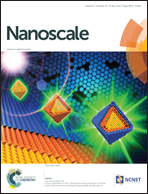Computational studies on the reactivity of alkyl halides over (Al2O3)n nanoclusters: an approach towards room temperature dehydrohalogenation†
Abstract
The role of alumina nanoclusters as a catalyst on the reactivity of alkyl halides has been explored. The thermochemical data obtained from Density Functional Theory (DFT) calculations and the analyses of the transition structures reveal that, between the two competing reactions, elimination (via E2) versus dissociative addition (via SN2), elimination is the kinetically controlled one and thus at room temperature, olefin is the major product. The results are in excellent agreement with the recent experimental observation where more than 97% of ethylene is formed at room temperature with the reaction of ethyl fluoride over an alumina surface, although the dissociative addition product is being thermodynamically more stable. We have tried to rationalize the fact by using alumina clusters of different sizes as well as different alkyl halides having β-H for elimination. It has been shown that, during the elimination (E2) pathway, the transition structure is oriented in such a way that the eliminating halogen and the β-H are in the interacting position with the three-centered Al and two-centered O atoms, respectively, where the Lewis acid/base interaction is the main guiding factor. We have also shown a possible pathway for regenerating the catalyst. Finally, the possibility of the reactions has been tested in the presence of H2O to mimic the same on the hydrated alumina surface.



 Please wait while we load your content...
Please wait while we load your content...